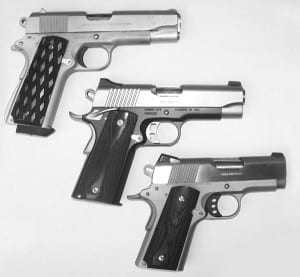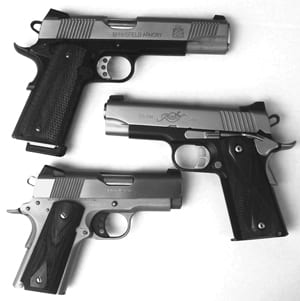This article was originally posted by GunDigest, to view the original article click here
If there is a legitimate criticism of the 1911 as a carry gun, it is size and weight. The pistol is thin but long and heavy. Do not let anyone convince you the 1911 is dated. It is simply from another era in which handguns were designed to save your life and were not based on liability concerns. The pistol is designed to be as fast as a good boxer, with a well timed and devastating blow foremost.
The Colt Commander is the result of a desire for a lighter and handier 1911. While the story goes the Commander was designed to offer the military a downsized pistol, there had been prototypes of a short .45 kicking around Hartford before World War II.
The use of aircraft grade aluminum for the frame allowed a very light and handy concealment piece. The Commander retains the full size grip of the Government Model. This allows comfortable firing and a good sharp draw. Size has much to do with confidence and control. Although it is appreciably lighter than the Government Model, the Commander is a controllable handgun – with practice.
With the Series 70 production run the Combat Commander Colt was introduced. This is simply a steel frame Commander. The Combat Commander is now known as simply the Commander while the aluminum frame Commander is the LW Commander. The steel frame Commander offers excellent balance. The problem with reducing the length of the pistol as far as reliability was the higher slide velocity, which was addressed by spring technology.
But then we also had a shorter spring that had to exert more pressure. The shortened slide length reduces the total reciprocating mass but also alters the way the magazine presents the round to the breech face. In the end, it was a wonder the Commander was so reliable. It’s a great pistol.

The Officer’s Model was the original short 1911, with a 3.5-inch barrel and grip shortened enough to cut magazine capacity by one round. Today most compact pistols have 3-inch barrels. The Officer’s Model demanded considerable revision of the design but the 3-inch pistols even more so. In order to accommodate the sharper barrel tilt in a short slide pistol, the barrel no longer used a barrel bushing. The Commander used a standard bushing, although it was shortened.
The Defender features a belled barrel that contacts the slide directly. One of the standard 1911 locking lugs was removed in order to allow the barrel to recoil proportionately more to the rear of the pistol. These design changes were essential in order to produce a functioning short slide handgun.
The 3-inch idiom has proven very popular. The Officer’s Model is now out of production and seems unlikely to return. These three idioms – the Government Model, the Commander and the Officer’s Model – were once the defining descriptor of 1911 frame and slide sizes. Today Government Model, Commander and Defender are more apt descriptions of the increasingly popular compact and ultra-compact descriptions.
A new and very popular handgun is the 4-inch barrel 1911. Some of the best of the modern 1911s are 4-inch guns. These include the Kimber Pro Carry, the Kimber CDP, the Para TAC FOUR and the Springfield Champion. The 4-inch barrel 1911s are more in line in size and weight with the popular service pistols from other makers such as the SIG P226 or Glock Model 23. They are superior service pistols and take much drag off of the uniform belt. They are also ideal concealed carry pistols.
They are available in both aluminum frame and steel frame versions in weight ranging from about 26 to 33 ounces. These pistols feature the belled barrel type lockup as they are too short to utilize a barrel bushing properly. In my experience these are very reliable handguns. They clear leather quickly, get on target quickly, and offer excellent hit potential. They also rate high on the smile test, with most raters reacting favorably to the handling and accuracy potential of these handguns.



